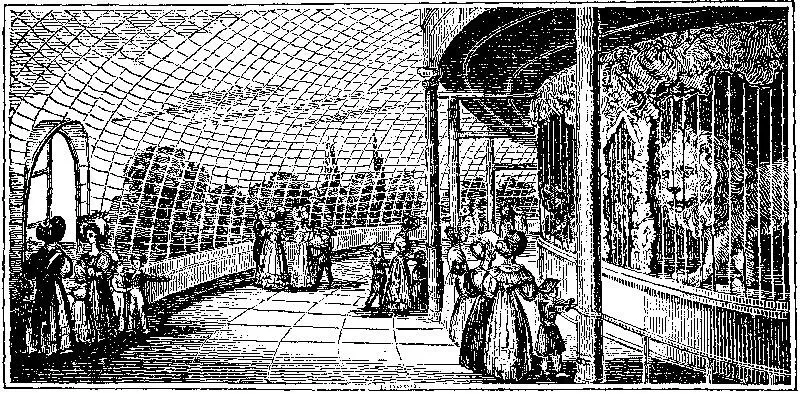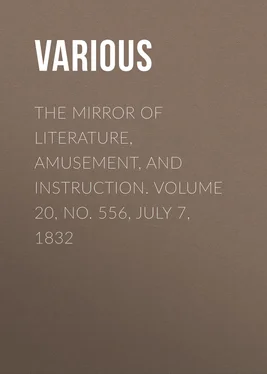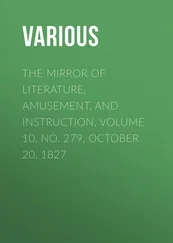Various - The Mirror of Literature, Amusement, and Instruction. Volume 20, No. 556, July 7, 1832
Здесь есть возможность читать онлайн «Various - The Mirror of Literature, Amusement, and Instruction. Volume 20, No. 556, July 7, 1832» — ознакомительный отрывок электронной книги совершенно бесплатно, а после прочтения отрывка купить полную версию. В некоторых случаях можно слушать аудио, скачать через торрент в формате fb2 и присутствует краткое содержание. Жанр: foreign_antique, periodic, Развлечения, foreign_edu, на английском языке. Описание произведения, (предисловие) а так же отзывы посетителей доступны на портале библиотеки ЛибКат.
- Название:The Mirror of Literature, Amusement, and Instruction. Volume 20, No. 556, July 7, 1832
- Автор:
- Жанр:
- Год:неизвестен
- ISBN:нет данных
- Рейтинг книги:3 / 5. Голосов: 1
-
Избранное:Добавить в избранное
- Отзывы:
-
Ваша оценка:
- 60
- 1
- 2
- 3
- 4
- 5
The Mirror of Literature, Amusement, and Instruction. Volume 20, No. 556, July 7, 1832: краткое содержание, описание и аннотация
Предлагаем к чтению аннотацию, описание, краткое содержание или предисловие (зависит от того, что написал сам автор книги «The Mirror of Literature, Amusement, and Instruction. Volume 20, No. 556, July 7, 1832»). Если вы не нашли необходимую информацию о книге — напишите в комментариях, мы постараемся отыскать её.
The Mirror of Literature, Amusement, and Instruction. Volume 20, No. 556, July 7, 1832 — читать онлайн ознакомительный отрывок
Ниже представлен текст книги, разбитый по страницам. Система сохранения места последней прочитанной страницы, позволяет с удобством читать онлайн бесплатно книгу «The Mirror of Literature, Amusement, and Instruction. Volume 20, No. 556, July 7, 1832», без необходимости каждый раз заново искать на чём Вы остановились. Поставьте закладку, и сможете в любой момент перейти на страницу, на которой закончили чтение.
Интервал:
Закладка:
Various
The Mirror of Literature, Amusement, and Instruction / Volume 20, No. 556, July 7, 1832
SURREY ZOOLOGICAL GARDENS
CIRCULAR BUILDING FOR LIONS, TIGERS, &c.

INTERIOR OF CIRCULAR BUILDING.
ROCKWORK FOR BEAVERS, &c.
SURREY ZOOLOGICAL GARDENS
[Although the reader will scarcely fail to recognise the typographical amendments contemplated in the Preface to our last volume, we may be allowed to point attention to the most important change. To give our souls "elbow-room," we have widened our columns so as to add upwards of two pages throughout each sheet of our future volumes: that is sixteen pages of the size of the present will be found to contain as much as eighteen pages the size of those in our last volume. But the page has not been widened like the citizen's back—at the expense of the corporation—or of the public. The whole of the type is new, having been cast, as the prospectus says, expressly for this work; its face is as brilliant as our hopes, and so, now, with the reader's permission, Flow on thou shining river.]
We commenced our last volume with three Vignette Views in the Surrey Zoological Gardens. The season was then cold and ungenial, the trees leafless; in short, it was about mid-winter, but the magic pencil of our artist invested his scenes with all the pride of summer. Upon the present occasion, our Engravings need not the aid of his creative fancy. The Gardens are now
made glorious by the summer sun
—the weather and the public are all propitious, and hundreds of gaily dressed folks are flocking to inspect the zoological and botanical curiosities of the place.
During the six months since our last visit, Mr. Cross has been indefatigable. The grounds have been laid out under the superintendance of Mr. Henry Phillips, the author of Sylva Florifera , and it is almost impossible to give the reader an idea of their beauty and variety. The avenues to the various buildings are planted with forest-trees, and each tree and new plant has its name affixed on a tally; a botanical garden, on a small scale, is, moreover talked of.
But we are forgetting the zoological tenants. The visiter enters by a broad walk, beside which Parrots, Maccaws, and Cockatoos are uncaged on perches; so that we may almost say with Montgomery:—
The blossoms swung like blossoms on the trees.
To the right is a semicircular glazed house containing many beautiful foreign birds, and two Boas, which, from their torpidity, appear nearly as harmless as their shaggy namesakes that encircle many a fair neck. The movable aviaries are too numerous to describe; but we must notice, in one of them, a fine pair of Great Crowned Pigeons from New Guinea; their front colour is a bright slate, as is that of their crests of fine silky feathers. We next pass the circular Confectionary room, and reach the curvilinear glazed building of 300 feet in diameter. ( See the Cut .) This has been planned by Mr. Henry Phillips; of the execution we spoke in The Mirror , No. 528. There are four entrances to this well-contrived building. Immediately within the wall, and all throughout the circle, is a channel of water containing gold and silver fish; from the margin of which plants are to be trained up within the glass. Next is a circular range of seats, then a broad walk, and in the centre of the building are placed the cages of carnivorous quadrupeds, as Lions, Tigers, Leopards, Hyaenas, &c. The Lions are especially worth notice: they are African and Asiatic, and the contrast between a pair from the country of the Persian Gulf with their African neighbours, is very striking. A sleek Lynx from Persia, with its exquisite tufted ears, and a docile Puma, will receive the distant caresses of visiters. The fronts of the cages are ornamented with painted rock-work, and our artist has endeavoured to convey an idea of the lordly Lion in his embellished dwelling. The whole building is admirably ventilated.
Another addition is an octagonal walled enclosure, the entrances to which are surmounted by pairs of magnificent horns. Here are cages for large birds, as the Ostrich, Emu, and Cassowary; and foreign pecora , as the Llama and Camel, and a pair of Gnus of great beauty.
Next is an enclosure containing two pair of fine Pelicans, and the solitary kennels of an Alpine and Cuban Dog: the Armadillo house, with a pair of eight-banded inmates: near the latter a sty or cage is preparing for Porcupines. At this extremity of the grounds, is the Deer paddock, with about forty specimens, among which the Axis or spotted varieties are very beautiful. We now reach a picturesque group of rock-work, ( See the third Cut ), the lower part of which is intended for Beavers, the upper craigs being at present occupied by Vultures and Eagles. The rock-work consists chiefly of granite, with a few masses of the rock of Gibraltar.
Of the lake, hermitage, and boathouse we have already spoken. The long, or rather semicircular, glazed building is now finished for the Monkeys, as is an adjoining house for large birds of prey: here we should notice a fine Ruppell Vulture, from Senegal, (named after Major Ruppell, the celebrated traveller in Africa,) a chanting Falcon from Brazil, and a white Hawk, from New Holland, the latter especially rare in this country.
Among the improvements we ought not to omit the affixing of the scientific and popular names to the abodes of the respective animals. This is one of the beneficial results of the honorary aid of Messrs. Swainson and Gray, the distinguished zoologists.
By the way, there has been in these grounds a Fancy Fair with the laudable object of aiding the funds for the repair of the Ladye Chapel of St. Saviour's Southwark. We anxiously hope the faire ladyes were successful in their appeal to the fancy of their visiters.
THE LATE MR. COLTON
Having observed in several papers and periodicals, (amongst which is The Mirror , No. 553,) sketches of "the late Mr. Colton," and none of these tending, in my opinion, to convey a correct idea of the character of this extraordinary man; allow me to offer you a slight sketch of the latter period of his life.
I am aware I shall be met by many with the squeamish proverb, De mortuis nil nisi bonum ; though I am not disposed at this moment to enter on a discussion of the merits of this received axiom. Shakspeare tells us "The evil that men do, lives after them."
Mr. Colton, or as he was vulgarly called, Parson Colton, arrived in Paris in the year 1825 or 1826, from America, to which country he sailed from England shortly previous to the murder of Weare. He was at that time in possession of very little money; this small stock he increased by borrowing upon the security of some valuable jewellery which he took out from his creditors in this country. With this sum he commenced his career as player at the public gaming-tables in Paris, more particularly that at 154 in the Palais Royal. The system upon which he played was at once bold and original, and attended with great success. I have good authority (his own) for stating, he was at one period a winner of upwards of £10,000. He subsequently lost nearly half this sum, and he expended the remainder in paintings by the ancient masters, of which, in the year 1828, he had a splendid collection. These pictures he intended for the English market; but in the latter part of the same year, he became unfortunate at the gambling tables, and they were parted with by degress, the proceeds lost, and their late owner, in a short time, reduced to beggary, or nearly so. His last literary labour, if it is worthy of the name, was a history of the Three Days of July, published by Galignani.
Читать дальшеИнтервал:
Закладка:
Похожие книги на «The Mirror of Literature, Amusement, and Instruction. Volume 20, No. 556, July 7, 1832»
Представляем Вашему вниманию похожие книги на «The Mirror of Literature, Amusement, and Instruction. Volume 20, No. 556, July 7, 1832» списком для выбора. Мы отобрали схожую по названию и смыслу литературу в надежде предоставить читателям больше вариантов отыскать новые, интересные, ещё непрочитанные произведения.
Обсуждение, отзывы о книге «The Mirror of Literature, Amusement, and Instruction. Volume 20, No. 556, July 7, 1832» и просто собственные мнения читателей. Оставьте ваши комментарии, напишите, что Вы думаете о произведении, его смысле или главных героях. Укажите что конкретно понравилось, а что нет, и почему Вы так считаете.












